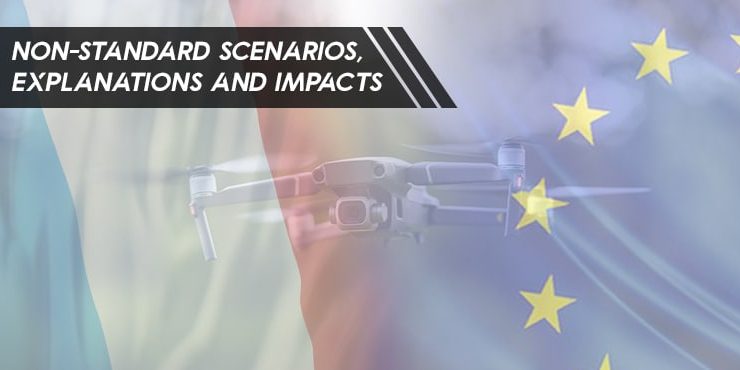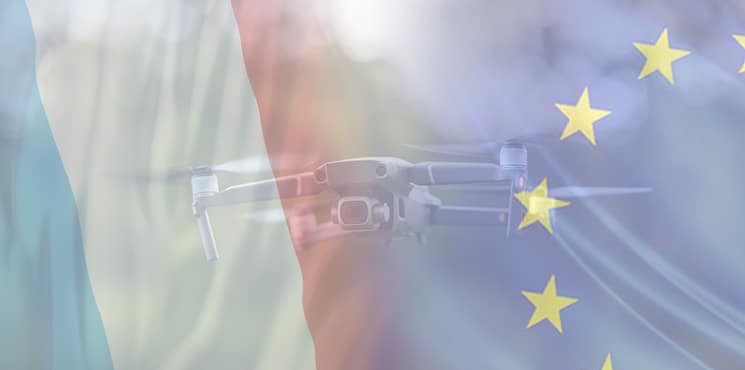Non-standard and European drone scenarios: good to know.
From December 2, 2021 (the date could be postponed by 2 years), any new drone operator will have to use European scenarios as part of their ConOPs. Existing drone operators will be able to continue carrying out their missions under national scenarios (S1, S2, S3) until December 31, 2023 if they wish. Today’s post aims to recall the European drone scenarios defined under European drone regulations with a strong focus on non-standard scenarios.
European drone scenarios of the open category
There are 3 European scenarios: A1, A2 and A3. They concern low-risk operations: visual flights at a height of less than 120 meters outside the public space of urban areas with class UAS C0, C1, C2, C3, C4.
Classless series drones will be able to operate in a limited open category (A1 limited, A2 limited, A3 limited) during the transition period. These are the same scenarios with a few more stringent restrictions.
European drone scenarios of the specific category
The standard scenario (STS-1) covers line-of-sight operations (VLOS) carried out with a class C5 UAS (CE marked) at a maximum height of 120 m above a controlled area on the ground in a populated environment and / or unpopulated. This scenario has strong similarities with the national S3 scenario (in populated areas).
The standard scenario (STS-2) covers operations that can be carried out out of sight (BVLOS) in an unpopulated or sparsely populated environment, with the UAS located at a maximum distance of 1 km from the remote pilot. This distance can be increased to 2 km if airspace observers are present.
The evolutions take place at a maximum height of 120 m above a controlled area on the ground in an environment with low population density, with a UAS of class C6 (CE marking). This scenario has strong similarities with the national S2 scenario.
Non-standard European drone scenarios
The open and specific categories cover the vast majority of drone uses. However, in rare cases it may be necessary to fly outside of these scenarios. Three cases were identified by the aviation authorities:
- SORAs (Specific Operations Risk Assessment)
SORA is a systematic risk assessment methodology for the types of drone operations subject to prior authorization. The method makes it possible to establish a sufficient level of confidence for the DGAC to grant an operating license to the operator.
It allows the evaluation of the concept of operation envisaged and its breakdown into 6 specific levels of assurance and integrity (S.A.I.L.). It then recommends the objectives to be achieved for each level of S.A.I.L., in line with the means to be implemented to make these risks acceptable and therefore theft possible.
The authorization request (covering one or more operations) is made to the DSAC / IR.
- PDRAs (Pre-Defined Risk Assessment)
PDRAs are used for classless drones, for drones whose characteristics do not allow classification or for drones operating in specific high risk environments.
It aims to simplify the authorization procedure as the risks (SAIL) have already been assessed using the SORA methodology by EASA.
There are two types of PDRA: PDRA-S (These PDRAs are modeled on European STS, except that the drone does not carry a class identification label) and PDRA-G (These PDRAs cover other types of exploitation relatively common in the EU).
- PDRA-S01 (PDRA “mirror” of the STS-01), allowing to fly under the conditions of this scenario without a CE marked C5 drone but with similar characteristics, to be demonstrated by the operator;
- PDRA-S02 (STS-02 “mirror” PDRA), allowing flight under the conditions of this scenario without a CE-marked C6 drone (but with similar characteristics, to be demonstrated by the operator);
- PDRA-G01 (formerly PDRA-01). Flight out of sight in sparsely populated area, at less than 120m in height, less than 1km distance from the remote pilot, or at a maximum distance of 1 km from a visual observer of the drone (also called “EVLOS”: flight in extended view) ;
- PDRA-G02: sight flight in sparsely populated area in airspace reserved for the operation;
- PDRA-G03: flight out of view in “atypical” space (space sufficiently close to the ground or to obstacles for it to be possible to estimate that the probability of encountering a manned aircraft is very low) in an area of low population.
Possible applications are, for example: surveillance by autonomous drone, logistics transport drone above an industrial site, etc.). This PDRA is being evaluated by the EASA.
- PDRA-G04: long-distance out of view type flight in non-segregated space and sparsely populated area (applications: high elongation operations, network surveillance, etc.).
Additional traffic detection measures (ADS-B in, FLARM, etc.) and notification to other airspace users are implemented to ensure a low probability of collision with a manned aircraft. It is on this PDRA that the continuation of “type S4” operations after 2021 will be based.
This PDRA is currently being evaluated by EASA.
- LUC (Light UAS Operator Certificate)
The LUC is the equivalent of part of the MANEX. It contains in particular: (i) The privileges of the operator; (ii) The types of authorized operations; (iii) The applicable procedures; and (iv) A safety management system.
LUC holders have to meet high standards. In return, this legal entity obtains the right to practice with certain privileges.
It is intended for professional operators who mainly carry out repetitive operations. The operator holding an LUC can then carry out flights without having to make a declaration or obtain an administrative authorization.
It must be approved by a competent authority (DSNA or DSAC / IR) unlike the MANEX that we usually use. Hold an L.U.C. is very restrictive and not suitable for smallholders. The L.U.C. is rather intended for large contractors.
Conclusion
On January 1, 2021, the MAP disappeared from a national regulatory point of view in favor of the MANEX. This regulatory change thus allowed a French UAS operator to be able to operate in any European state (harmonization of operating procedures between the different member states.
During 2021, the DGAC, for the sake of supporting the transition, allowed operators to use their MAP under the name MANEX by: (i) Removing any reference to articles of law 2012, 2015 and 2017 ; (ii) Compliance with the decrees of December 20, 2020, in particular on night flights, French digital identification devices, etc.
As a drone operator, you will have to redesign your MANEX from December 2, 2021 using the European framework defined by EASA which will be put online at the end of July 2021 by the DGAC (Directorate General of Civil Aviation) .
This is evolving strongly and you will be asked to describe your activity in a much more detailed and structured way, called Concept of Operations (ConOPS). One of the key points of the change in regulations concerns the fact that the operator must specify for each of its ConOPS the list of aircraft and personnel authorized for execution.
In addition, there are many uncertainties regarding the time that will be necessary for drone manufacturers to approve their new drones (class of drones). It is therefore interesting for operators to find out about PDRAs or SORAs.


